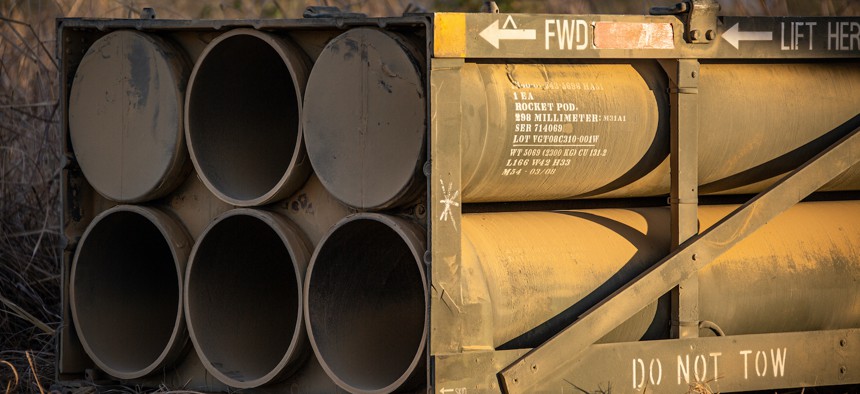
Guided Multiple Launch Rocket Systems staged on the ground before an emergency fire mission during Exercise Koolendong at Bradshaw Field Training Area, NT, Australia, Aug. 29, 2021. U.S. Marine Corps / Cpl. Colton K. Garrett
Lockheed wants a rocket motor maker of its own, for GMLRS and more
An in-house source of solid-fuel engines might help boost Ukraine’s supply of the punishing artillery system.
Lockheed Martin is hunting for another supplier of solid rocket motors for a key weapon the U.S. is sending Ukraine.
The company depends on Northrop Grumman and Aerojet Rocketdyne for motors that power the heavy artillery called Guided Multiple Launch Rocket System, or GMLRS.
“When it comes to solid rocket motors, I mean, we're actually starting with GMLRS for example, a legacy technology, where we want to augment our existing supplier, and have" a third source, Lockheed CEO Jim Taiclet said Tuesday during the company’s third-quarter earnings call.
There are two main rocket motor manufacturers in the U.S.: Aerojet Rocketdyne, which was bought this year by L3Harris Technologies, and Orbital ATK, which was purchased by Northrop in 2018.
In June, defense contractor Anduril announced it had acquired Andranos, a smaller solid rocket motor supplier—in a bid to bring competition to an “industry facing heavy consolidation.”
Taiclet said Lockheed is “in negotiations and discussions with a counterparty,” but did not name the company they’re eyeing.
That company could be X-Bow Systems, an analyst said. The Pentagon recently gave $64 million to X-Bow to “expand manufacturing capacity and reduce the production cost of solid rocket motors used in hypersonic weapons,” and Lockheed is already partnering with the company.
Lockheed told Defense One this summer that it was concerned L3Harris’s acquisition of Aerojet would block its access to rocket motors needed for its missiles—thoughL3Harris executives have rejected that claim.
Still, standing up another supplier will bring “antifragility” to Lockheed’s supply chain, Taiclet said.
“This is not a one-time objective. This is a broad, in a way campaign-like, approach to strengthening our own supply chain and enabling multiple sources really for even beyond our company, for our industry, which I think is important,” he said.
During the company earnings call, Taiclet said the current “challenging” global threat environment is “refocusing” the U.S. and its allies on national defense.
If there is another continuing resolution, or a government shutdown, Congress may consider supplemental requests to support Ukraine, Israel, and Taiwan, given “rising tensions” around the world, Taiclet told investors.
“As Congress continues to work through the FY-24 appropriations bills, we are optimistic that there will be consistent support for the national defense strategy and funding for its priorities,” he said.
Taiclet also provided an update on the F-35 program. The company has delivered 80 jets this year, and expects to deliver 17 more by the end of the year. The first aircraft with the newest technology configuration, dubbed TR-3, is still on track for delivery between April and June next year, Taiclet said, following multiple delays.
“We are producing F-35s at a rate of 156 per year and expect to continue at that pace while simultaneously working to finalize TR-3 software development and testing,” Taiclet said.
Looking ahead, Lockheed is still “cautiously optimistic” it will finalize a new deal next year to sustain the F-35 fleet, despite ongoing negotiations with the Pentagon, said company chief financial officer Jay Malave.
Correction: An earlier version of this report said Lockheed obtains GMLRS rocket motors from a single "existing supplier," as Lockheed CEO Jim Taiclet put it. But Taiclet misspoke; his company also buys the motors from Aerojet Rocketdyne.


